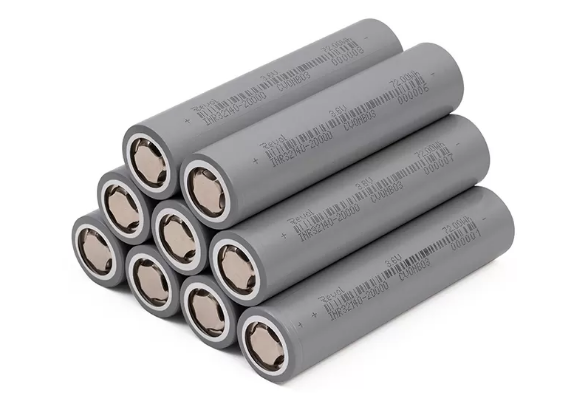What is the Difference Between IMR, ICR, INR, and IFR 18650 Battery?
Understanding the differences between IMR, ICR, INR, and IFR 18650 batteries is crucial for selecting the most suitable battery for your specific needs. Each classification represents a distinct chemical composition and performance profile, making it essential to choose the right type for optimized usage. This article provides a detailed analysis of IMR, ICR, INR, and IFR 18650 batteries, focusing on their unique properties and ideal applications.

Part 1: IMR 18650 Battery
I: Lithium (Li)
M: Manganese (Mn)
R: Round Cell (R)
Chemical Composition
IMR 18650 batteries, short for "Lithium Manganese Oxide Rechargeable," use lithium manganese oxide (LiMn₂O₄) as their cathode material. This specific chemical composition gives these batteries unique characteristics that influence their performance and safety.
Advantages
- Enhanced Safety: The use of lithium manganese oxide results in a safer chemistry, significantly reducing the risk of thermal runaway and enhancing stability during charge and discharge cycles.
- Lower Internal Resistance: IMR batteries have lower internal resistance, which allows for higher discharge rates. This makes them ideal for high-drain devices that require rapid bursts of power, such as vaping devices and high-powered flashlights.
Disadvantages
- Energy Density Concerns: IMR batteries may have slightly lower energy density compared to other 18650 variants. This can impact overall battery life or capacity, making them less suitable for prolonged, low-power applications.
Applications
IMR 18650 batteries are widely used in devices that require immediate energy output, including:
- Vaping Mods: Their ability to discharge power quickly makes IMR cells a popular choice in the vaping community, providing rapid bursts of energy for vaporization.
- Portable Lighting Systems: High-performance flashlights and portable lighting systems benefit from IMR batteries due to their capacity for delivering immediate high power when necessary.
- Power Tools: Devices such as power drills and saws that demand quick and substantial power bursts find IMR batteries particularly suitable for their high-drain requirements.
Part 2: ICR 18650 Battery
I: Lithium (Li)
C: Cobalt (Co)
R: Round Cell (R)
Chemical Composition
ICR 18650 batteries, known as "Lithium Cobalt Oxide Rechargeable," utilize lithium cobalt oxide (LiCoO₂) as their cathode material. This unique chemical composition sets them apart from other 18650 variants and plays a crucial role in determining their performance and safety characteristics.
Advantages
- High Energy Density: ICR batteries are known for their impressive energy density, allowing them to store significant amounts of energy compared to many other 18650 counterparts.
Disadvantages
- Safety Concerns: The lithium cobalt oxide chemistry can pose safety risks, especially in high-drain scenarios. ICR batteries are more prone to overheating and instability, making effective safety management essential.
- Lower Discharge Rates: These batteries typically exhibit lower discharge rates than certain variants like IMR, which limits their effectiveness in high-drain applications that require rapid power delivery.
Applications
ICR 18650 batteries are particularly suitable for devices that prioritize high capacity over immediate high power output:
- Consumer Electronics: Devices such as laptops, digital cameras, and various portable electronics benefit from ICR batteries, as their high capacity provides stable power output for extended periods.
- Low-Drain Devices: Gadgets that require consistent but not immediate power, such as specific medical devices or low-power flashlights, commonly utilize ICR batteries for reliable energy provision.
Part 3: INR 18650 Battery
I: Lithium (Li)
N: Nickel (Ni)
R: Round Cell (R)
Chemical Composition
INR 18650 batteries, known as "Lithium Nickel Manganese Cobalt Oxide Rechargeable," incorporate a combination of nickel, manganese, and cobalt in their cathode material. This unique blend directly influences their overall performance and stability.
Advantages
- Balanced Performance: INR batteries offer a balance between capacity and discharge rates, providing both decent energy storage and sufficient power output.
- Improved Stability: Compared to variants like ICR cells, INR batteries are more stable and less prone to overheating, especially in high-drain applications.
Disadvantages
- Moderate Energy Density: INR batteries may have slightly lower energy density than some other variants, which can affect the total capacity and runtime.
- Moderate Capacity: While more balanced, INR cells may not offer the same high capacity as ICR batteries, making them less ideal for applications requiring maximum energy storage.
Applications
INR 18650 batteries are suitable for devices needing a balance between power output and capacity:
- Portable Electronics: Laptops, power banks, and certain electronic tools benefit from INR batteries due to their ability to deliver stable power over moderate durations.
- Moderate-Drain Devices: Devices such as mid-range flashlights or moderate-power appliances often use INR batteries, as they offer a good balance between energy capacity and power output.
Part 4: IFR 18650 Battery
I: Lithium (Li)
F: Iron (Fe)
R: Round Cell (R)
Chemical Composition
IFR 18650 batteries, short for "Lithium Iron Phosphate Rechargeable," use lithium iron phosphate (LiFePO4) as the cathode material. This distinct composition sets them apart from other 18650 types, giving them unique performance characteristics.
Advantages
- Enhanced Safety: IFR batteries are highly regarded for their excellent safety profile. The lithium iron phosphate chemistry minimizes the risk of thermal runaway and instability, making them one of the safest battery options.
- Longevity: These batteries have an extended cycle life, outperforming other 18650 variants in terms of durability. This longevity makes them popular for applications where long-term use is essential.
Disadvantages
- Lower Energy Density: IFR batteries have a lower energy density compared to some other 18650 types, meaning they can store less energy for their size.
- Moderate Discharge Rates: While they offer stable performance, IFR batteries may not be suitable for applications requiring rapid power delivery, as their discharge rates are lower than high-drain options like IMR.
Applications
IFR 18650 batteries are well-suited for devices prioritizing safety and longevity:
- Solar Power Storage: Their high safety and long lifespan make IFR batteries ideal for solar energy storage systems, where reliability over extended periods is critical.
- Electric Vehicles: Electric cars, bikes, and scooters benefit from IFR batteries due to their durable and stable performance, ensuring consistent, long-lasting power in high-usage scenarios.
Part 5: Differences Between IMR, ICR, INR, and IFR 18650 Batteries
Similarities
- All Lithium-Ion: IMR, ICR, INR, and IFR batteries are part of the lithium-ion family, utilizing lithium-based chemistries.
- Rechargeable: Each of these batteries is rechargeable, capable of being charged and discharged multiple times before replacement is needed.
Differences
1. Chemical Composition
- IMR: Lithium Manganese Oxide (LiMn₂O₄)
- ICR: Lithium Cobalt Oxide (LiCoO₂)
- INR: Lithium Nickel Manganese Cobalt Oxide
- IFR: Lithium Iron Phosphate (LiFePO₄)
2. Performance Characteristics
- IMR: Features lower internal resistance, enabling higher discharge rates ideal for high-drain devices.
- ICR: Offers high capacity but poses safety risks due to potential overheating in high-drain scenarios.
- INR: Balances capacity and discharge rates, making it suitable for moderate-drain devices.
- IFR: Prioritizes safety, stability, and longevity, though it has a lower capacity and discharge rate.
3. Applications
- IMR: Suited for high-drain devices such as vaping mods, power tools, and high-powered flashlights.
- ICR: Used in low-drain devices like laptops, digital cameras, and other portable electronics.
- INR: Ideal for moderate-drain applications such as laptops, power banks, and mid-power tools.
- IFR: Commonly used in solar power storage systems, electric vehicles, and applications where safety and longevity are essential.
4. Safety and Longevity
- IMR & IFR: Generally considered safer than ICR due to their more stable chemistries. IFR especially excels in safety and long cycle life.
- INR: Provides a balanced trade-off between safety, performance, and moderate longevity.
- ICR: Requires careful safety management, particularly in high-drain situations where overheating is a concern.

Comments